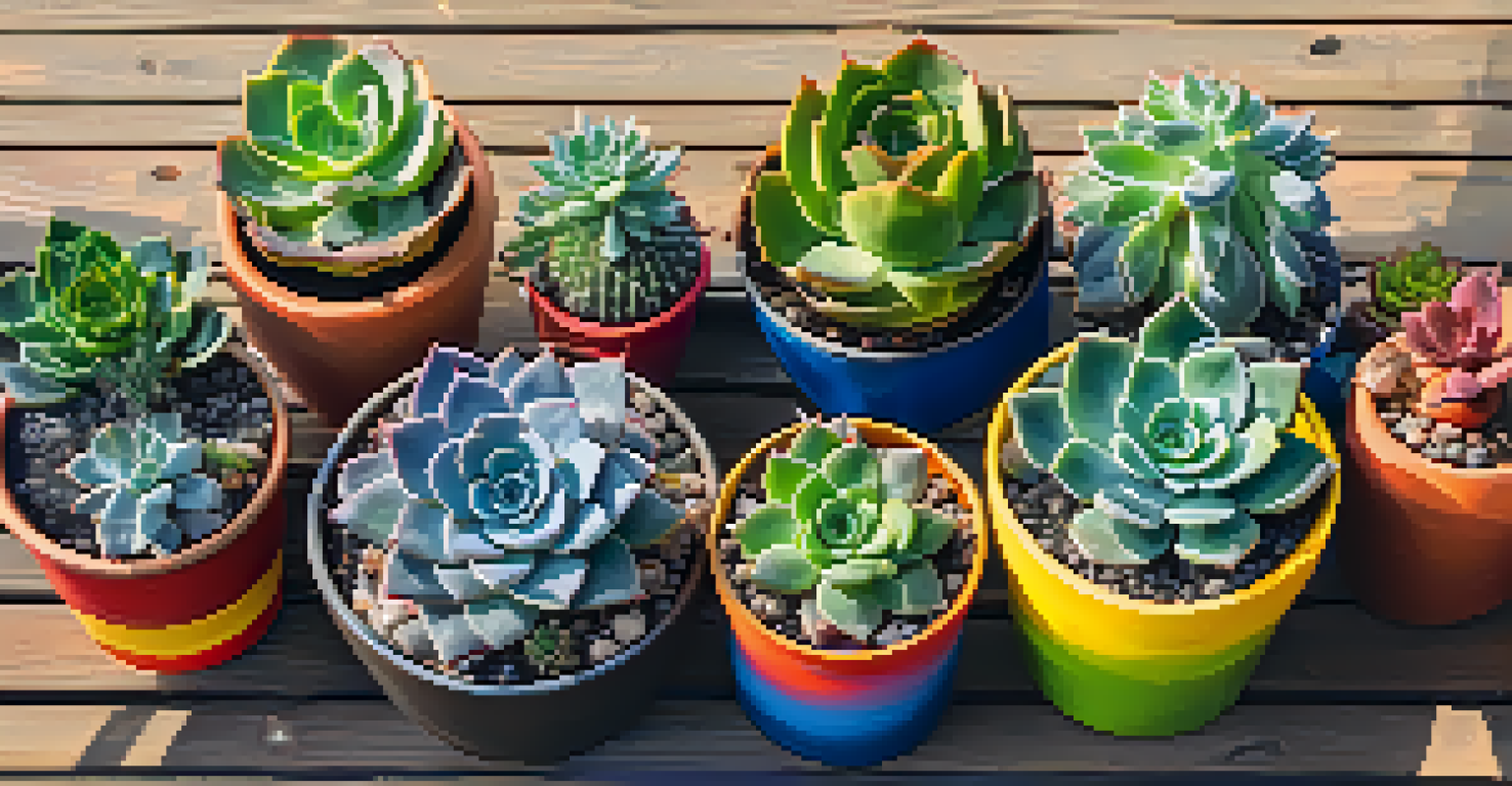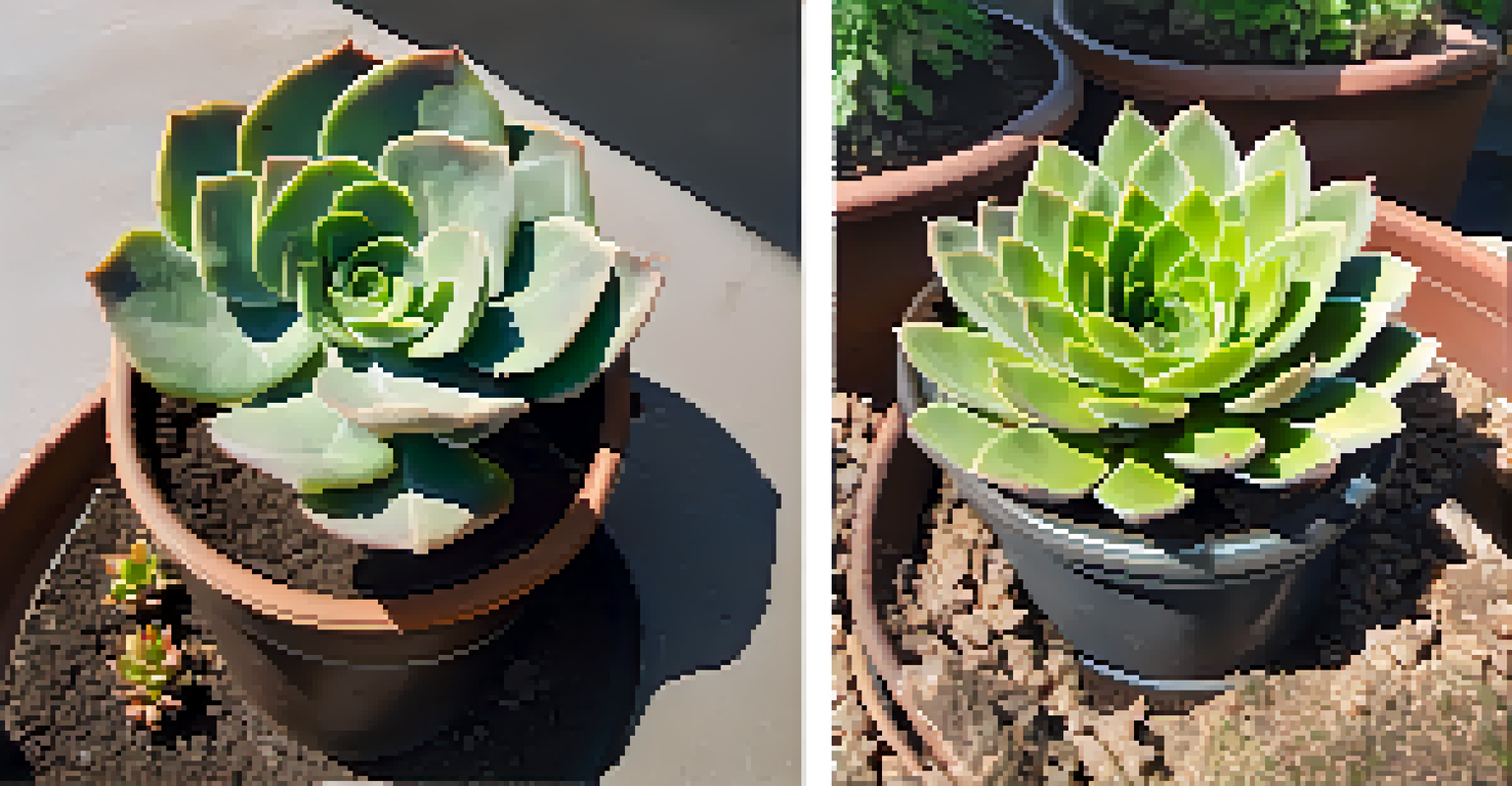Signs of Overwatering: How to Save Your Succulents Quickly

Understanding the Importance of Proper Watering
Succulents are unique plants that thrive in arid environments, making proper watering essential. Unlike traditional houseplants, they store water in their leaves, stems, and roots, allowing them to survive long periods without moisture. Understanding their watering needs helps prevent overwatering, which can lead to serious issues.
Plants are like people; they thrive when they receive the right care and attention.
The general rule of thumb is to water succulents only when the soil is completely dry. This could mean watering once every week or two, depending on the climate and the plant's specific needs. By paying attention to the plant's environment, you can ensure they remain healthy and vibrant.
Recognizing the signs of overwatering early on can save your succulents from irreversible damage. Let's explore some common indicators that your plants might be getting too much water.
Recognizing the Signs of Overwatered Succulents
One of the first signs of overwatering is a change in leaf texture. Instead of being firm and plump, overwatered leaves may become mushy or soft. This change indicates that the plant is absorbing more water than it can handle, leading to a potential rot situation.

Another telltale sign is discoloration. If the leaves start to turn yellow or brown, it's a warning that the succulent's health is declining. Keep an eye out for these color changes, as they often signal that your watering routine needs adjustment.
Watering Succulents: Key Guidelines
Understanding proper watering techniques is essential to keep succulents healthy and prevent overwatering.
Lastly, drooping leaves can also indicate overwatering. While succulents may droop due to lack of water, if the leaves are mushy and drooping, it’s usually a sign that they’re too saturated. Understanding these signs can help you take quick action.
Checking the Soil Moisture Level
To accurately assess whether your succulent is overwatered, checking the soil moisture is crucial. Stick your finger about an inch into the soil; if it feels damp, it’s time to hold off on watering. Succulents thrive in dry conditions, and soggy soil is a clear indication of excess moisture.
The greatest gift of the garden is the restoration of the five senses.
You can also use a moisture meter, which can provide a more precise reading of the soil's water content. This tool is particularly helpful for those who struggle to gauge dryness by touch alone. Monitoring soil moisture regularly can prevent overwatering situations from arising.
If you find that the soil retains too much water, consider repotting your succulent into a well-draining mix. This proactive step can be vital in restoring your plant's health and ensuring it gets the right amount of moisture.
Assessing the Roots: A Key to Recovery
If you've confirmed that your succulent is overwatered, it may be time to check the roots. Carefully remove the plant from its pot and inspect the roots for signs of rot, which will appear brown or black and mushy. Healthy roots should be white or light tan and firm to the touch.
If you notice any rotten roots, it's essential to trim them away with clean scissors. This will help prevent further rot from spreading to healthy parts of the plant. Remember, the goal is to save what you can, so focus on the healthy root sections.
Signs of Overwatering to Watch For
Recognizing changes in leaf texture, discoloration, and drooping can indicate that your succulent is receiving too much water.
After trimming, allow the plant to dry out for a few hours before repotting it in fresh soil. This process helps reduce moisture levels and gives the succulent a fighting chance to recover.
Repotting: The Fresh Start Your Succulent Needs
When repotting, choose a pot with drainage holes to ensure excess water can escape. Opt for a cactus or succulent mix that promotes good drainage, as this is essential for the plant’s recovery. The right soil can make a world of difference in how your succulent absorbs and retains moisture.
Gently place your succulent in the new pot and fill it with fresh soil, making sure not to bury the leaves. Maintaining proper leaf exposure helps prevent future rot issues. After repotting, avoid watering for a week to allow the plant to acclimate to its new environment.
This fresh start can rejuvenate your succulent, allowing it to thrive once again. Patience is key; give your plant time to recover from the stress of overwatering.
Establishing a Better Watering Routine
Once your succulent is on the road to recovery, it’s crucial to establish a consistent watering routine. Consider factors such as the season, temperature, and humidity levels, as these can all affect how quickly the soil dries out. Creating a watering schedule tailored to your plant's needs can help prevent future overwatering.
A good practice is to water thoroughly but infrequently. This means giving the plant a good soak until water drains out of the bottom and then allowing the soil to dry out completely before watering again. Over time, you’ll get a feel for what works best for your specific succulent.
Root Health is Crucial for Recovery
Inspecting and trimming rotten roots is a vital step in helping overwatered succulents get back on track.
Keeping a journal of your watering schedule might also help you notice patterns in your plant's growth and health. With time, you’ll become more attuned to your plant’s needs.
Learning from Experience: The Key to Thriving Succulents
Every plant parent makes mistakes, and overwatering succulents is a common one. The key is to learn from these experiences and adapt your care routine accordingly. By understanding your plants' needs and observing their responses, you’ll become a more confident caregiver.
Don’t hesitate to seek advice from fellow succulent enthusiasts. Online communities and forums can provide valuable insights and tips on best practices for succulent care. Sharing experiences can help you avoid pitfalls and improve your gardening skills.

Remember, the journey of plant care is a learning experience. With each succulent you nurture, you'll gain more knowledge and expertise, leading to healthier, happier plants.